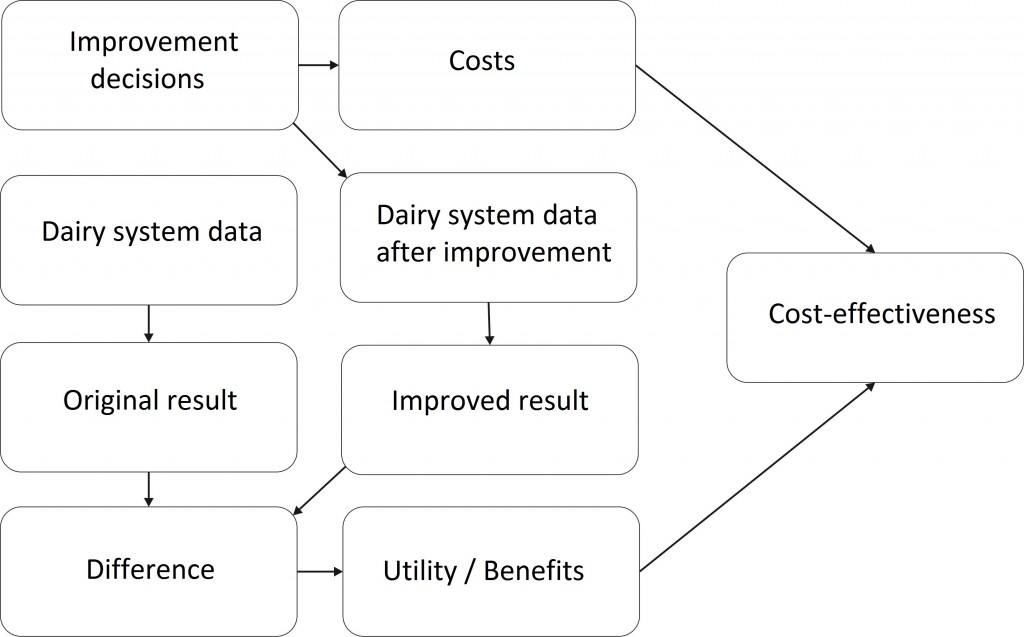New tools are under development in SOLID, transforming information on how to reduce the environmental impacts into customised, cost-effective suggestions.
By Sampsa Nisonen, WP4
The knowledge on environmental impacts of dairy farming is steadily increasing and when we seek to reduce environmental impacts of dairy farming, our decisions should be based on this knowledge. Climate change is easily the most researched impact category, followed by eutrophication and biodiversity. These impacts are very different by nature, but linked through their common origin in dairy farm activities. This means that when an action is taken to reduce one impact, it might have an effect on other impact categories as well. The effects could be either positive or negative, causing synergies or trade-offs. For example an action taken to reduce greenhouse gases could increase eutrophication or vice versa. Additionally, if cost-effective solutions are wanted, the monetary cost of the actions should be considered. If there are two actions with similar impacts but different costs, the cheaper one should take priority.
To choose an optimal set of improvement decisions all these points must be taken into account. Ideally, every relevant consequence of every pertinent action should be considered and the total achieved utility should be viewed in light of the total cost of these actions. With the optimal set of improvements, maximum utility per euro is attained.
New tools are under development in SOLID WP4, transforming research and knowledge on how to reduce the environmental impacts of dairy farms into customised, cost-effective suggestions.
To solve this optimisation problem, data from multiple sources is required. Naturally only a limited number of improvement options can be included in a practical model, so the first task is to compile a list of those actions, which have the most potential for effective reduction of environmental impacts. The list is based on the Rapid Assessment Tool constructed in WP 1 and FAO’s suggestions for sustainable agriculture. Life cycle assessments completed in WP 4 are used to calculate baseline results for the three environmental impacts investigated: climate change, eutrophication and biodiversity loss. The LCA results are complemented by data from expert interviews. The experts are asked to estimate two things: how much the environmental impacts change relative to the baseline results, when different improvement actions alter the dairy system and what the monetary costs for the improvements could be.
Bayesian networks (BN) are used as the primary modelling method and as framework for linking different types of data together. BN:s are probabilistic graphical models, which link a set of random variables together through conditional probabilities. BN:s are well suited for this type of decision support tool, because of their ability to deal with the uncertainties inherently present in the modelled system. The probabilistic nature of BN:s allows the interviewed experts to give their estimations as probability distributions that best describe their opinions and include their uncertainty as well. The final model calculates the results based on the average of these distributions. The network structure itself is useful, making it easy to model the connections between improvement actions and their consequences.
A simplified diagram of the model is presented in Figure 1. When data describing a dairy system – including typical LCA data and information on both the current and desired state of environmental improvements – is inserted into the model, it can calculate the probability distributions for different environmental impacts before and after improvements. The difference in impact is interpreted as utility or benefits and by dividing it by the expected cost we can estimate the cost-effectiveness of the chosen set of improvement decisions. Computer software can be used to automatically calculate the optimal set, which gives the greatest amount of expected utility per euro.
Climate change, eutrophication and biodiversity loss are measured in different units, which makes it difficult to compare decision that lead to reductions different impacts. If all three impact categories could be measured in same units, it would be easy to see where to focus the limited resources. Environmental valuation studies offer one way of converting different impacts to the same unit, in this case money. Another way would be to use separate tools to calculate separate results for each impact category, which could then be compared qualitatively.
The goal is to make the decision support tools available in the Internet. Currently separate tools are planned for the UK, Denmark and Finland to take regional differences into account.
AUTHOR



